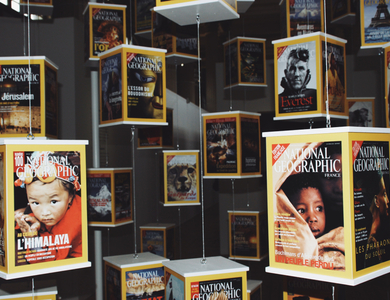
National Geographic’s Social Media Prowess
National Geographic’s Digital and Social Media Strategy
Read MoreBefore we get too philosophical (and scientific), this blog post is about the ideation and brainstorming process. It’s about harnessing data-driven techniques to increase the likelihood of successful ideation sessions. It’s about giving you a framework so that you can implement a workshop with your team or your client.
But I know what you’re thinking. Well, I’m making a broad assumption that I know what you’re thinking. Yet another one of those “ideation” blog posts. Yet another one of those buzzwordy articles about something that should just be called what it truly is—talking about things in order to come up with ideas. So #AgencyLife, right?
Ideation is kind of that. It’s a buzzword, for sure. It’s a thing. But it’s a thing that has had a really good agent. It’s a product-innovation spin-off of the traditional brainstorm.
It’s brainstorming 2.0, yet it needs to be defined in order for us to see the similarities and the dissimilarities to that out of which it grew.
It is slightly funny, and ironic, that we have to classify the process of vocalizing a larger-than-usual number of ideas as something other than a large amount of ideas. But I am casting so many stones because we name everything here at [B]RIGHT Brand Performance Group, and I love everything about the process of naming something. It tangilizes (a new word I just invented; I have the best words) it. It gives it a personality. It gives it a soul.
So back to the brainstorming (we’ll cover the basis for naming things in a different blog post—we just have to come up with a good name for it first) origin story. The process harks back to the 1940s, and the term was coined by Alex Osborn. It was based on “do not pass judgment on ideas until the completion of the brainstorming session..”
All these are qualifiable things. All good things, we agree. But we also know that idea sessions existed before the mighty brainstorm came along, and we know that without a process and structure, brainstorming sessions usually just devolve into one or a few people dominating 60–75 percent of the conversation, according to Creative Conspiracy author and academic Leigh Thompson. So adding more structure and technique to brainstorming was necessary to eliminate the influence of a minority of participants, foster collaboration, and directly address the groupthink psychology.
Brainstorming was in need of structure, boundaries, and swim lanes in order to perform successfully. Much like my children.
In came ideation. Organized. Structured. Technical. And it was part of a more consistent and inclusive creative process—a process with a goal of using exercises and techniques to foster idea generation.
In came the smartphone and the brainstorming flip-feature phone watched with teary eyes. In walked ideation and made the past 70 years look like no more than a free ride on cruise control for brainstorming.
So what exactly is ideation? Well, its end goal is the exact same as brainstorming: (original) idea generation. It just takes a more robust and structured approach to get there.
Ideation has been defined in these ways:
Ideation is more than just a buzzword, because (by default) a buzzword implies that it has a lack of substance. And for ideation, that’s just not true. Ideation is a substantive and structured approach to idea generation.
We all know that we have a brain. Most of us use it to generate ideas—different types and kinds of ideas. Creative, functional, fun, sad, ingenious, and genius ideas. At any point in this process, you’re either accessing your left brain hemisphere or your right. Your right brain is thought to be the source of your artistic, musical, emotional, intuitive, and problem-solving ideas. Your left brain is presumed responsible for more traditional linear thinking, like logic, science, analysis, and mathematical functions.
There’s no end in sight for think pieces and write-ups on the “brainstorming is not as great as ideation” phenomenon (and this is certainly one of them). But what we do know about the effectiveness of the idea-generation process is summarized (eloquently and scientifically) below:
7 Tips for a Consistent and Successful Ideation Process
Make sure that you invite only the stakeholders who have something to add to the process. These should be people who are vested in the project, who have some background information, and who will ultimately guide the project forward.
Don’ts:
Dos:
Breaking the ice properly is probably the most important part of successfully conducting an ideation session. If you’re not able to alleviate—and, ideally, eliminate—anxiety, break down internal communication barriers, and loosen people up, the success rate of this collaborative session will decrease immensely.
Icebreakers should be fun and should get participants to open up and feel comfortable contributing. There are tons of different icebreaker exercises out there, but here are some of our favorites.
Go around the table and ask each person, “If you were stranded on a deserted island, which three people would you want with you (dead, alive, or famous)?”
Divide the group into two or a few small groups. Tell the newly formed groups that their assignment is to think for a minute and then to share with their group the one word that describes x. It could be a company, a brand, a person, or anything else that would spur conversation.
Announce at the beginning of the meeting that no one is allowed to smile whatsoever. It’s a lot harder than it sounds, and you’ll see reverse psychology start to take place.
There’s never a moment lost in ideation when a successful and desired outcome is clearly defined and communicated. The importance here lies in defining what deliverables or tangible assets you would like to get by performing this workshop. Literally spell it out. You want 20 headlines for a blog? You need five comps for a catalog cover? You want 30 content-marketing topics? You want 10 tweets?
Be as specific, literal, and direct as possible when explaining the purpose of the session. The more clarity you add, the more likely you are to have a successful project.
After that’s done, you’ll also want to make sure that you spell out the ideation process, its different parts, how it works, and what will happen after the session is complete. Clearly set an agenda with times allocated for all parts of the session: introductions, icebreakers, ideation techniques, and wrap-up.
The desired outcome of an ideation session is only attainable when everyone knows the expectations, what their role is, and what the soft boundaries are that will guide the session.
The person most suited to communicate these boundaries and ensure that the session is moving along according to the agenda should be in the lead. This should be someone who is a good communicator and facilitator. It should be someone with diplomacy skills and a project-management background. Maybe it will be an account coordinator or executive. Or perhaps it will be a project manager. Someone who is used to herding cats.
Now you’re ready to kick off the session. You’re ready to get down to brass tacks and generate the best ideas. But instead of just blurting out things that come to mind, let’s consider a few different structured techniques that we can harness to guide the process to a more consistent and desired outcome.
While there are tons of great ideation techniques out there, the key is to find techniques that fit your team’s skills, abilities, and philosophies. Here are two creative ideation techniques that work well for agencies.
If you work on a team with people who spend their free time sketching, doodling, and creating, this particular technique should line up with the passions, skill sets, and expertise of creative types.
This technique focuses on group sketching and consists of the following quick steps:
The goal is to align and harness visual cues as a means of conceptualizing ideas. It’s also a lot of fun.
In order to use our other senses and not always rely on vision and hearing, it can be really beneficial to exercise and use our less-used senses. This can be especially helpful if we’re conceptualizing a visual deliverable (like a logo or something similar).
Here are four simple steps to implementing a sensory ideation technique:
The goal of this is to generate ideas and look at an otherwise mundane item in a different way—outside the box, if you will. Make sure that you stay on schedule. Make sure that you take regular breaks in between techniques to reset the brain. Make sure that you have fun.
The results are in, and you have a bunch of scattered and great ideas. What now? Now it’s time to curate, organize, and rank your findings. You can do this offline or as part of a final step in the ideation process. The first step would be to vet the ideas for feasibility. Oftentimes, when we’re in ideation sessions we come up with awesome moon-shot ideas that might not always be in scope or attainable. Make sure these are ranked in a separate category.
For the ideas that seem actionable, rank them in the order of your own choosing. You can use something as simple as Post-it notes on a whiteboard, ranking them by whatever scale you think fits. Something as simple as “good, better, best” can really work wonders in defining the ideas that should be weeded out and the ones that are keepers. You could also do this offline if you think participation will be better. You can use an anonymous voting system to rank your ideas, or do both to see if there are any anomalies.
By this time you should have a number of valid ideas that could be implemented. This is exciting. Before we end the session and let everyone go about their business, we have one more step to take care of.
Thank everyone for participating. This is a given, but often we forget how busy everyone is. Making sure that all attendees are thanked properly for their participation is not only good manners, but it’s also the proper setup for creating a good impression of the session.
Before letting them all go, you’ll also want to give participants an optional task: to continue thinking about the project with a goal of seeing what other, inadvertent ideas might come after the workshop. Shower thoughts, drive-time thinking, etc., can facilitate other ideas. These offline ideas are often valid and should be considered, because not all of us are on-the-spot thinkers. Some of us need some extra time to digest the parameters of a project in order to properly formulate really good responses. Give participants a 24-hour window. After 24 hours the brain should have moved on.
Finally, this is the time to communicate the next steps for the project. What is the next step, and when does it occur? Who’s involved?
To recap, here’s the above process paraphrased and synopsized (a word I just made up; wait, no, this is actually a word—we have the best words).
I know, I took some liberties in paraphrasing the importance of these techniques and processes, but I just couldn’t help myself. Levity is needed in life. But I digress.
The main takeaway after each successful session is to regroup and see where there are opportunities for improvement. Reviewing the results is one thing, but it’s almost equally important to review the process, the techniques used, the participants, and the facilitator to deduce possible areas of improvement.
There’s an extension to the old brainstorm process that is capturing additional attention: brainwriting. This process focuses on capturing ideas through a more quiet process, separating discussion from the equation. Brainwriting has been found to “generate 20 percent more ideas and 42 percent more original ideas compared to traditional brainstorming groups,” Leigh Thompson wrote in Creative Conspiracy.
With all these newfangled words and processes, what is in store for the future? How do we harness all this information into actionable things? How do we capture all these wonderfully ideated ideas physically?
Well, we live in a place where everything seems to be either powered by AI, some sort of bot, or a virtual assistant, so the traditional use of the whiteboard is going by the wayside. In comes whiteboard 2.0, such as the Google Jamboard, which takes the concept from traditional to futuristic Minority Report status. This is the future—as long as you have the cash to put down on a whiteboard (I’d love to be a fly on the wall when you propose that to your CFO, btw).
Or you could just get on the F train (F for future), and use an app like Storme to take your process from brainstorming to media-rich presentation in no time. This is also the future.
Better yet, heed the words of the Onion’s lead video writer and foster a collaborative and safe creative space. This is not the future or the present. This is just following good practices.

National Geographic’s Digital and Social Media Strategy
Read More
Tesla Motors: Inspiration in Design, Innovation in Marketing
Read More
In late 2018, the very first ‘virtual store’ emerged in a Starbucks in China, offering customers a digital and personal customer experience like no other.
Read More